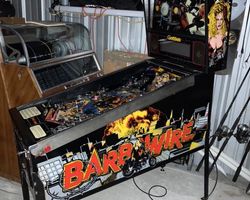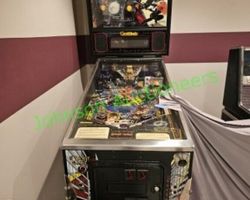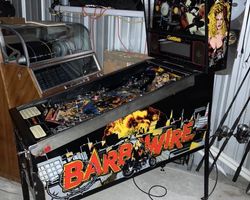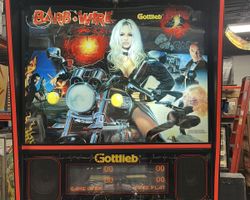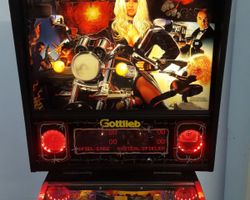Barb Wire

Average Prices: USD $700 to $1,600
Produced: April, 1996
Production Run: 1,000 units
Machine Type: Solid State Electronic
MPU: Gottlieb System 3
Players: 4
Design by: Bill Parker
Art by: Constantino Mitchell, Scott Melchionda, Jeanine Mitchell
Dots/Animation by: Scott Melchionda
Music by: Duane Decker
Sound by: Craig Beierwaltes
Software by: Jon Norris
The pinball machine "Barb Wire," released in April 1996 by D. Gottlieb & Co. under its Premier Technology brand, holds a distinctive place in pinball history as the very last production game to roll off Gottlieb’s assembly line. This machine emerged at a challenging juncture for the industry, particularly for Gottlieb, which would cease pinball production shortly after its release while attempting to launch a "Brooks & Dunn" themed game. With a limited production run of just 1,000 units, "Barb Wire" is an artifact of a bygone era, serving as the final chapter for a company that had contributed to the pinball landscape for decades.
The machine draws its theme directly from the 1996 action film of the same name, starring Pamela Anderson. This direct tie-in to a contemporary cinematic release was a common strategy in the pinball world, aiming to capitalize on pop culture relevance. Behind the machine’s creation was a dedicated team: Bill Parker designed the playfield, Constantino Mitchell and Jeanine Mitchell crafted the distinct artwork, Jon Norris developed the software, Duane Decker composed the music, Craig Beierwaltes engineered the sound, and Scott Melchionda brought the display animations to life. The collaboration aimed to translate the gritty, dystopian aesthetic of the film into an interactive pinball experience, complete with custom speech featuring voice lines from the movie's star. Marketing slogans such as "Go Haywire In This New Pinball From Gottlieb" and "Pinball With Attitude" succinctly captured the intended aggressive and energetic tone of the game.
Signature Features and Design
"Barb Wire" distinguishes itself through several unique elements that both define its visual identity and enhance the gameplay. Central to the machine's allure is the integration of its movie theme, directly influencing the artwork and various interactive components. The playfield and backglass artwork, rendered by Constantino and Jeanine Mitchell, present a stylized interpretation of the film’s post-apocalyptic setting and its titular character. This artistic approach, while polarizing for some, undeniably provides "Barb Wire" with a bold, unmistakable presence.
A prominent feature enhancing gameplay is the "Big Fatso" mechanism, a kinetic toy integrated into the playfield. This character, directly from the film's narrative, manifests as a physical door that moves up and down. Its movement dynamically alters the shot availability, either opening access to the mode start saucer or providing a target for a Mega Bonus. This interactive element transforms a static playfield into a dynamic environment, requiring players to adapt their shot timing based on Fatso's position. Furthermore, the game incorporates a Dot Matrix Display (DMD), allowing for custom animations designed by Scott Melchionda, which visually reinforce the game's modes and objectives, contributing to the overall player immersion. The inclusion of Pamela Anderson's voice for custom callouts further grounds the machine in its source material, providing an authentic layer of thematic engagement.
Playfield and Mechanics
The "Barb Wire" pinball machine offers a robust and engaging playfield layout, designed by Bill Parker, that promotes fast-paced action and strategic shot-making. The playfield features a conventional two-flipper arrangement at the bottom, complemented by a crucial upper flipper positioned above a captive ball. This third flipper allows for targeted shots to the right ramp, adding a layer of precision to gameplay. The layout incorporates two distinct ramps—a left ramp and a right ramp—which are integral to shot combos and mode progression. These ramps are designed to return the ball swiftly, maintaining a high tempo.
Major shot targets are strategically distributed across the playfield. A single pop bumper cluster contributes to erratic ball movement and score accumulation, also advancing the cursor along the "BARB WIRE" letters for various awards. A captive ball sits above the upper flipper, acting as an arrow shot and lighting the right ramp for specific combos. The "Retina Scan" kickout hole serves as a mystery award dispenser, offering a variety of beneficial outcomes including "HAYWIRE" letters, extra balls, and multipliers. A "Lower Right Kickout Hole" awards the "Mind Read" feature, while a "Lower Right Target" lights the "Mega Bonus" at the "Big Fatso" mechanism. Four "Lens Targets" are prominently placed and become critical during the "Hammerhead Bar" mode. The general flow of the playfield is designed to encourage continuous action, with shots often feeding back into play or offering opportunities for follow-up combos. The artwork, a blend of movie stills and original illustrations, establishes a distinct, gritty aesthetic, complementing the overall theme, though some playfield areas can appear visually darker, requiring good lighting.
Gameplay Dynamics
"Barb Wire" offers a gameplay experience centered on completing a series of themed rounds to reach a culminating wizard mode, Haywire. The game's dynamics are generally fast-paced, emphasizing a combination of precise shot execution and timely strategy. A dual plunger system allows for both manual and automatic launches, with a "Skill Shot" rewarding a full plunge that directs the ball accurately to the left flipper.
Progression in "Barb Wire" is structured around initiating and completing various rounds, each with unique objectives. The "Hideout" round, for instance, is a non-multiball mode where players aim to score at the Big Fatso, Retina Scan, and Mind Read holes. "Big Fatso" itself is a multiball round, where the value of shots to the Big Fatso mechanism alternates, encouraging players to hit it repeatedly. The "Crash the Tolls" round is a one-ball objective focused on shooting arrow shots to collect escalating toll values. "Hammerhead Bar" introduces another multiball scenario, requiring players to complete the four "Lens Targets" before focusing on subsequent hits for points, with an extra ball awarded for hitting five.
The game boasts a 4-ball multiball, offering a timed ball save to encourage engagement. Beyond the main rounds, the "Retina Scan" kickout hole is a pivotal element, awarding a range of benefits including "HAYWIRE" letters, extra balls, score multipliers, and various jackpots, making it a high-value target throughout gameplay. Completing all major arrow shots awards "Firefight Multiball," adding another layer of strategic depth. The "BARB WIRE" letters, advanced by pop bumper hits, can also lead to significant awards. The ultimate objective is "Haywire," the wizard mode. Initiated by collecting all "HAYWIRE" letters, this multiball frenzy lights all shots, offers a generous ball saver, and continuously increases bonus values, providing a rewarding climax to skilled play. The rules, while initially appearing straightforward, reveal surprising depth as players delve into the various modes and understand how to chain shots and capitalize on the "Retina Scan" awards.
Reception and Legacy
"Barb Wire" elicits a mixed but often passionate response within the pinball community, a reflection of its unique position as Gottlieb's final production machine and its adherence to a divisive licensed theme. One of the most frequently discussed aspects is its theme and artwork, which are either embraced by fans of the movie and its star or dismissed as dated or overtly risqué. The backglass, in particular, has garnered attention for its bold portrayal of Pamela Anderson. Complementing this, the custom callouts featuring Anderson's voice, while authentic to the theme, are often described as "cheesy" by some players.
Despite the polarizing thematic elements, the gameplay of "Barb Wire" frequently earns positive remarks. Many players find the game surprisingly engaging, citing its fast-paced action and the inherent challenge. The playfield layout is generally well-regarded for its design and flow, offering a good variety of shots and ramps that contribute to enjoyable combos. The "Big Fatso" mechanism is a standout, praised for its unique interaction and impact on shot strategy, as is the skill shot. The "Haywire" mode is consistently highlighted as a particularly satisfying wizard mode. Reviewers often note that the rules, while not overly complex, possess enough depth to keep players interested beyond initial plays, and the game’s various multiball modes, including the timed ball save, are appreciated. For some, the game's relatively forgiving nature to newer players makes it an accessible title.
However, "Barb Wire" is not without its criticisms. Some players find certain shots too easy or repetitive, and a "clunk" sound from the ramps and flippers is occasionally noted. The scoring balance is sometimes questioned, and the absence of a video mode is a point of contention for those accustomed to such features in machines of this era. Given its tie-in to a film that received a generally poor critical reception, this often influences perceptions of the pinball machine itself.
"Barb Wire's" legacy is undeniably shaped by its status as Gottlieb's final bow. Its low production numbers contribute to its relative rarity, making it a sought-after piece for collectors interested in the complete history of pinball manufacturers. While it may not be universally lauded as a top-tier title, it represents a significant historical marker, showcasing Gottlieb's System 3 platform's reliability and its design team's efforts in a challenging market. For enthusiasts, "Barb Wire" stands as a testament to the perseverance of a pinball company in its twilight, offering a distinctive, albeit polarizing, gameplay experience that continues to spark discussion and enjoyment among those who appreciate its unique charm.
Sponsored Links
 Ebay Listings
Ebay Listings
 Auction Results
Auction Results
| Cost | Location | Date |
|---|---|---|
| USD $1,525 |  Georgia, United States Georgia, United States |
14 November, 2025 |
| USD $3,250 |  Pennsylvania, United States Pennsylvania, United States |
02 April, 2025 |
| USD $2,000 |  Indiana, United States Indiana, United States |
17 March, 2025 |
| USD $1,425 |  Georgia, United States Georgia, United States |
24 February, 2025 |
| USD $4,000 |  Florida, United States Florida, United States |
18 September, 2024 |
| USD $2,999 |  Florida, United States Florida, United States |
04 May, 2024 |
| EUR €2,499 |  Schlewig-Holstein, Germany Schlewig-Holstein, Germany |
30 December, 2022 |
| USD $1,400 |  Pennsylvania, United States Pennsylvania, United States |
21 March, 2020 |
| EUR €1,460 |  Bayern, Germany Bayern, Germany |
27 September, 2019 |
| USD $2,200 |  North Carolina, United States North Carolina, United States |
20 August, 2019 |


Private Policy · Search Website · Contact Us
As an eBay Partner, we may earn a commission from qualifying purchases made through links on this site, at no additional cost to you.
All trademarks and copyrighted materials remain property of their respective owners. All other content copyright 2007 - 2025 Pinpedia.

